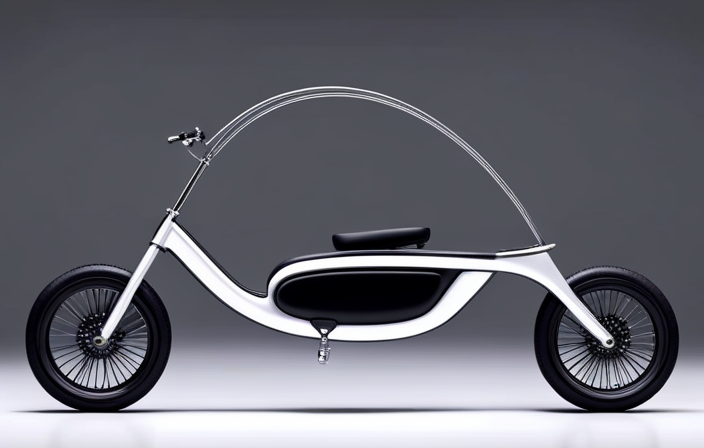You might be thinking, ‘Why would I need to remove the back tire from my electric bike?’ Well, there are a few reasons.
Maybe you need to repair a punctured tire or replace a worn-out one. Or perhaps you want to upgrade to a new, more durable tire. Whatever the reason, knowing how to remove the back tire from your electric bike is an essential skill for any bike owner.
In this article, I will guide you through the step-by-step process of removing the back tire from your electric bike, ensuring that you can handle any maintenance or upgrade needs that come your way.
Key Takeaways
- Find a flat and stable surface for workspace.
- Loosen bolts and slide off brake calipers.
- Turn off electric bike and disconnect battery.
- Ensure stability and safety throughout the process.
Gather the necessary tools and equipment
Before you can remove the back tire from your electric bike, you’ll need to gather the necessary tools and equipment.
First, prepare your workspace by finding a flat and stable surface to work on. This will ensure stability and safety throughout the process.
Next, you’ll need to remove the brake calipers. Start by loosening the bolts that attach the calipers to the frame using an appropriate wrench or Allen key. Once the bolts are loose, carefully slide the calipers off the brake rotor and set them aside.
Now, you’re ready to move on to the next step of turning off the electric bike and disconnecting the battery, which will ensure a safe working environment.
Turn off the electric bike and disconnect the battery
First, make sure to power down the e-bike and disconnect the battery. This step is crucial for ensuring safety during the process of removing the back tire.
Here’s a step-by-step guide on how to disconnect the battery:
- Locate the battery compartment, usually located on the frame of the electric bike.
- Use a screwdriver or a tool specifically designed for battery removal to unscrew the battery compartment cover.
- Carefully disconnect the battery by unplugging the connector. Be gentle to avoid damaging any wires or connectors.
By disconnecting the battery, you eliminate the risk of accidental electric shock or damage to the electrical components.
Now that the battery is disconnected, we can move on to the next step, which is shifting the bike to a low gear. This will make it easier to remove the back tire smoothly.
Shift the bike to a low gear
To make it easier, shift the e-bike to a lower gear. Shifting techniques play a crucial role in removing the back tire of an electric bike. By shifting to a lower gear, you reduce the tension on the chain and make it easier to remove the tire. This is especially important if you have a hub motor or a derailleur system.
Gear maintenance is also essential for smooth shifting and preventing any damage to the bike’s drivetrain. Make sure to regularly clean and lubricate the chain, check the gear cables for any signs of wear, and make any necessary adjustments. By properly maintaining your gears, you’ll ensure that your bike performs optimally and is easier to work on.
Now, let’s move on to the next step – loosening the axle nuts or quick-release skewer – to continue removing the back tire.
Loosen the axle nuts or quick-release skewer
Next, you’ll need to loosen either the axle nuts or the quick-release skewer.
When removing the back tire from an electric bike, it’s important to understand the different types of axle nuts or quick release skewers that may be used. Some electric bikes have traditional nuts that require a wrench to loosen, while others have quick-release skewers that can be loosened by hand. It’s crucial to identify which type your bike has before proceeding.
Additionally, when loosening the axle nuts or quick-release skewer, there are common mistakes to avoid. One mistake is not fully loosening the nuts or skewer, which can lead to difficulty in removing the tire. Another mistake is not properly aligning the wheel when reattaching it, causing potential damage to the bike.
Now that we’ve loosened the axle nuts or quick-release skewer, let’s move on to releasing the tension on the chain or belt.
Release the tension on the chain or belt
Once you have loosened the axle nuts or quick-release skewer, you can proceed to release the tension on the chain or belt.
To adjust the chain tension, locate the chain tensioner on the rear derailleur or rear dropouts. Use a wrench or Allen key to turn the tensioner screw clockwise to increase tension or counterclockwise to decrease tension. Ensure that the chain is properly aligned on the sprockets and that there is about half an inch of vertical movement when pressing down on the chain at its midpoint.
If you have a belt drive system, troubleshooting common belt problems involves checking for proper alignment, tension, and any signs of wear or damage.
Once the chain or belt tension is adjusted, you can move on to removing the wheel from the frame.
Remove the wheel from the frame
First, make sure the axle nuts or quick-release skewer are fully loosened before proceeding to take the wheel off the frame.
To safely remove the back wheel of an electric bike when changing the rear tire, follow these steps:
- Place the bike upside down or use a bike stand for stability.
- Use a wrench or Allen key to loosen the axle nuts or release the quick-release skewer.
- Slide the chain or belt off the rear sprocket.
- Lift the bike frame slightly and carefully pull the wheel out of the dropouts.
- Set the wheel aside and continue with the tire replacement.
Now that the wheel is removed, it’s time to inspect the tire and inner tube for any damage.
Inspect the tire and inner tube for any damage
Take a moment to carefully examine the tire and inner tube for any signs of damage or wear. Inspecting tire pressure is crucial to ensure optimal performance and safety of your electric bike. Use a tire pressure gauge to check if the tire is inflated to the recommended pressure level, which is usually indicated on the sidewall of the tire. Additionally, carefully inspect the tire for any punctures or cuts that could cause a flat tire while riding. You can do this by running your fingers along the entire surface of the tire, feeling for any abnormalities. If you notice any punctures or damage, it is important to address them promptly to avoid further complications. Now, let’s move on to the next step of replacing or repairing any damaged components.
Replace or repair any damaged components
To ensure optimal performance and safety, it’s important to promptly replace or repair any damaged components you find during the inspection. If you notice a damaged brake, it is crucial to replace it immediately. Faulty brakes can compromise your ability to stop efficiently, which can be dangerous.
Additionally, if you encounter any motor issues, it’s essential to troubleshoot and address them promptly. This may involve checking the motor connections, inspecting the wiring for any damage, or consulting the manufacturer’s troubleshooting guide.
By addressing and resolving any damaged components or motor issues, you can ensure that your electric bike operates smoothly and safely.
Now that you have replaced or repaired any damaged parts, it’s time to move on to the next step: reinstalling the wheel onto the frame.
Reinstall the wheel onto the frame
Once you have successfully repaired any damaged components, you can now proceed to reinstalling the wheel onto the frame. It is important to follow these steps carefully to ensure a proper installation.
Here are five key points to keep in mind:
- Align the axle of the wheel with the dropouts on the frame.
- Slide the wheel into place, making sure it is centered and fully seated.
- Tighten the axle nuts or quick-release skewer, ensuring they are secure but not overly tight.
- Check the brakes to ensure they are properly aligned and functioning correctly.
- Spin the wheel to make sure it rotates smoothly without any rubbing or wobbling.
By following these steps, you can avoid potential issues and troubleshoot any problems that may arise during the reinstallation process.
Once the wheel is securely in place, you can move on to the next step of testing the bike to ensure proper functioning.
Test the bike to ensure proper functioning
After reinstalling the wheel onto the frame, it’s important to test the bike to ensure it is functioning properly. Testing the bike is crucial to identify any issues that may have arisen during the wheel reinstallation process. Here are some testing methods and troubleshooting techniques to consider:
| Testing Methods | Troubleshooting Techniques |
|---|---|
| Take a short ride | Listen for unusual sounds |
| Check the brakes | Check for any wobbling |
| Shift through gears | Verify smooth gear transitions |
First, take a short ride to assess the overall performance. Pay attention to any unusual sounds, such as squeaking or grinding, which may indicate a problem. Secondly, check the brakes to ensure they are functioning correctly and have proper tension. Additionally, test the gear shifting by shifting through the gears to ensure smooth transitions. Lastly, inspect the bike for any wobbling, which could suggest an issue with the wheel alignment. By following these testing methods and troubleshooting techniques, you can ensure your electric bike is back in proper working order.
Frequently Asked Questions
How do I gather the necessary tools and equipment to remove the back tire from an electric bike?
To gather the necessary tools and equipment for removing the back tire of an electric bike, I would start by ensuring I have a wrench, a tire lever, and a bike stand for stability. These tools will make the process much easier and efficient.
What precautions should I take before turning off the electric bike and disconnecting the battery?
Before turning off my electric bike and disconnecting the battery, I make sure to take the necessary precautions. This includes wearing protective gloves and eyewear, ensuring the bike is in a stable position, and following the manufacturer’s instructions to safely remove the battery.
Why do I need to shift the bike to a low gear before removing the back tire?
Shifting the bike to a low gear before removing the back tire is crucial to prevent the chain from slipping and causing damage. Proper technique for shifting gears on an electric bike is essential. Common mistakes to avoid when removing the back tire include not releasing the tension in the derailleur and not properly aligning the chain.
Can you explain in more detail how to loosen the axle nuts or quick-release skewer?
To loosen the axle nuts or quick-release skewer, start by locating them on the back wheel. Use a wrench or your hand to turn them counterclockwise until they are loose enough to remove.
Are there any specific steps I should follow to test the bike and ensure it is functioning properly after reinstalling the back tire?
After reinstalling the back tire, it’s important to perform testing procedures to ensure the bike is functioning properly. Start by checking the brakes, gears, and tire pressure. If any issues arise, refer to troubleshooting tips to address them effectively.
Conclusion
In conclusion, removing the back tire from an electric bike may seem daunting, but it can be done efficiently with the right tools and knowledge.
Just like our journey through life, sometimes we encounter obstacles that require us to take a step back and make necessary repairs.
By being prepared and taking the time to fix any damages, we can ensure a smooth ride ahead.
Remember, it’s not about how many times we fall, but how many times we get back up and keep moving forward.









